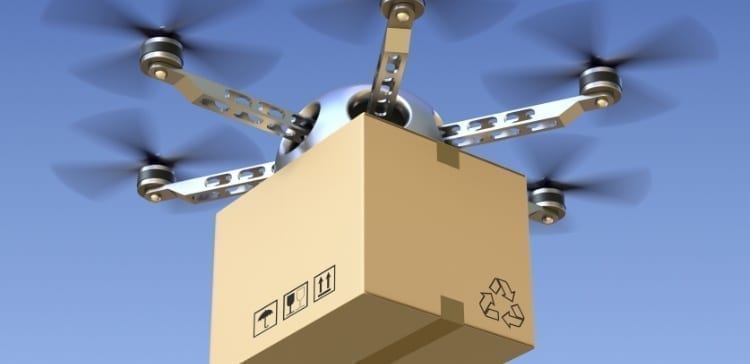What will they think of next?! That seems to be the question every time some breakthrough technology emerges, and today is no different after Amazon’s latest announcement. Yesterday, news broke of their newest R&D lab project: Prime Air. As the leaders in shipping efficiency, it should come as no surprise that they’ve been cooking up another plan to somehow hasten their shipping process. How fast will shipping be using Prime Air, you ask? 30 minutes or less!
While it sounds crazy, it’s 100% legit—Amazon promises no funny business. In their demonstration video above, they show exactly how the process will work from start to finish, using their neat-looking drone delivery aircrafts.
As soon as a consumer purchases an item on Amazon.com, the shipping process begins at the warehouse. The item is located, placed in a yellow bin labeled “Amazon Prime Air,” and then onto a conveyer belt. At the end of the belt, the Prime Air delivery vehicle is waiting to pick up the package, and as soon as it does, it takes off into the sky. The aircraft arrives at is destination, lands outside the door of the delivery location, drops off the package, and goes airborne once again to return to the warehouse. The video ends with two satisfied customers bringing the package into their home.
In an interview on CBS’s “60 Minutes,” Amazon CEO Jeff Bezos discussed some of the details of the Amazon Prime Air service. The aircraft is an octocopter, which has eight blades. They likely chose this design because it can still function if it loses one of its blades. The Prime Air vehicle is also equipped with a GPS that directs it to the delivery address.
Although the future seems to be closer than we imagined, there are still some setbacks, but not because the technology isn’t ready. “The hardest challenge in making this happen is demonstrating to the standards of the FAA that this is a safe thing to do,” Bezos explained, “This is years of additional work at this point.”
Certainly, the biggest hurdle for the project will be FAA regulations pertaining to drone aircrafts, seeing as current regulations do not permit them in US airspace at all. The FAA released their first draft of a roadmap meant for drone aircrafts in November as ordered by Congress, and plan to have drones operating by September 2015.
Many people have raised concerns when it comes to the use of drone aircrafts to deliver packages, a number of which focus on the fact that drones are used in warfare in other parts of the world. Believe it or not, that’s not what’s keeping the FAA from allowing delivery drones—the holdup is due to privacy concerns. Eight states have already passed laws against the use of commercial drones to collect surveillance data, according to the American Civil Liberties Union, and a major concern of delivery drones is the potential for drones to spy on citizens.
Another concern is safety, which could go without saying when you consider a swarm of Amazon Prime Air drones descending on a single apartment building on Cyber Monday. With those eight blades spinning presumably quickly, I can only imagine it wouldn’t feel good to run into one. Also, with the number of public bombings through which we’ve suffered in the recent past, the fear of these delivery drones being used for ulterior motives is real.
While the list of concerns could be endless, the potential for completely game-changing innovation is still really neat. We’re super excited to see how this plays out, what do you think? What are your biggest concerned about delivery drones, or drones in US airspace in general? Let us know on twitter @TCITechs or on our Facebook page!






